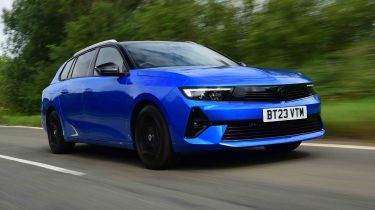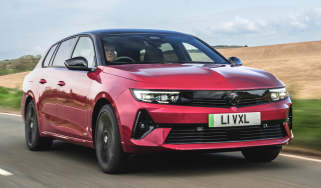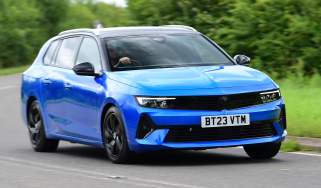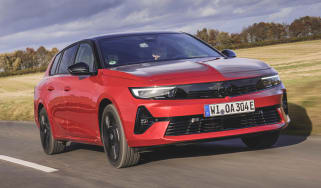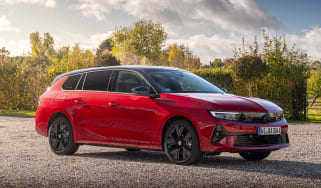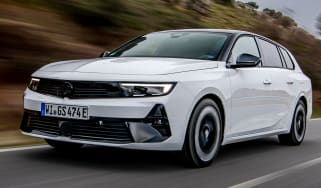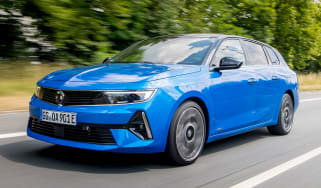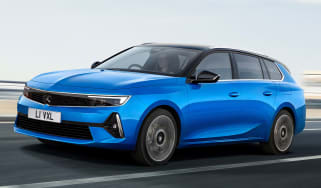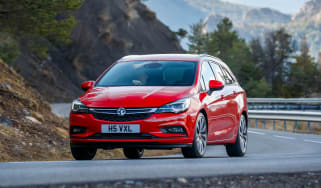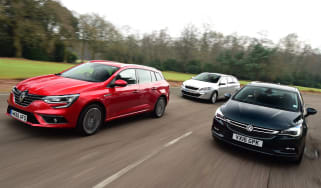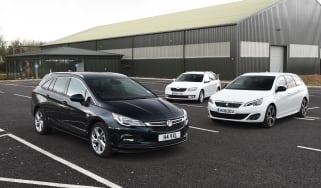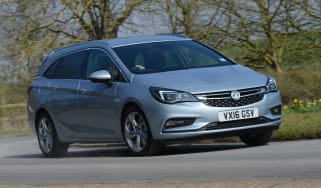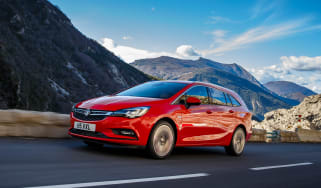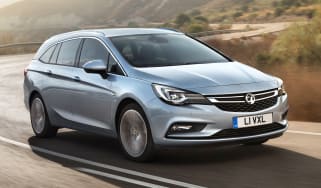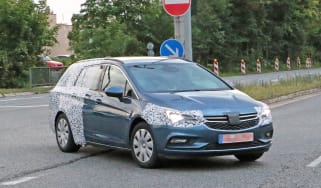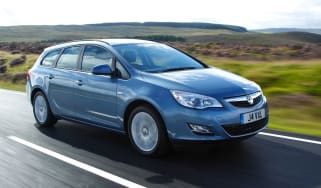Vauxhall Astra Sports Tourer review
Stylish looks, impressive technology, and various engine options make the Vauxhall Astra Sports Tourer a fine estate car choice

Even though the Vauxhall Astra Sports Tourer is the follow-up to the regular hatch, it is perhaps its best version to date, balancing the needs of practicality, efficiency, comfort, and a decent drive better than the original.
Yes, it could still do with a little more rear legroom, and its interior isn’t quite as posh as you’d expect from a model that can cost more than £40,000. But stick to the better value trim levels, and you'll have a well-equipped and repectably versatile estate car with a very wide selection of engine choices, from traditional petrol through to a more efficient mild-hybrid version for those unable to plug in, and up to the company car friendly plug-in hybrid and fully electric models – the latter of which helps the Astra Sports Tourer stand out against its rivals as being one of the few fully electric estates you can buy today.
About the Vauxhall Astra Sports Tourer
Vauxhall is on the road towards full electrification, and what better way to accelerate the process than by offering one of its most popular cars – the Astra – not only with a regular petrol engine, but with mild-hybrid, plug-in hybrid, and all-electric power.
Yes, you read that last one right. Now in its eighth generation, the Astra Sports Tourer (think estate, but with a marginally cooler name) will, for the first time, offer those who like to use their Astra to transport the family dog, shift furniture, or for the odd run to the local tip, the chance to do so under electric power.
Used - available now

2025 Vauxhall
Astra
39,835 milesManualPetrol1.2L
Cash £14,287
2021 Vauxhall
Astra
21,721 milesManualPetrol1.2L
Cash £13,100
2023 Vauxhall
Astra
8,711 milesAutomaticPetrol1.2L
Cash £18,900
2019 Vauxhall
Astra
67,207 milesManualPetrol1.4L
Cash £6,390For some Astra Sports Tourer buyers, that’ll be in up to 35-mile bursts in one of the two plug-in hybrid choices, but it could also be from the all-electric version that provides up to 256 miles of electric range.
The latter stands out as one of only a few estate cars available that are powered by volts alone, with your choices being the far pricier BMW i5 Touring, the Peugeot E-308 SW (the sibling to the Astra Sports Tourer Electric), and the Volkswagen ID.7 Tourer being the main rivals to this elongated Astra.
There are also two plug-in hybrids to consider. The first is the Hybrid 180, which will go up against plug-in hybrid versions of the Peugeot 308 SW, and SEAT Leon Estate, while the sportier GSe (Grand Sport Electric) version will go up against the Cupra Leon Estate.
Then there’s the petrol-powered 1.2-litre Astra Sports Tourer, which is likely to be the volume seller. It’ll compete against similarly powered rivals, from the Ford Focus Estate, Kia Ceed Sportswagon, the already mentioned 308 SW and Leon Estate, Skoda Octavia Estate, Toyota Corolla Touring Sports, and the Volkswagen Golf Estate. This version of Astra Sports Tourer has 128bhp and comes with a six-speed manual gearbox as standard, or an optional eight-speed automatic transmission. If you need better fuel economy, a mild-hybrid 134bhp e-DCT6 mild-hybrid version of this engine is available, which uses a small electric motor and battery to boost performance and lower fuel consumption and emissions.
Keeping things simple, the latest Astra Sports Tourer comes with five trim level options: Design (entry), Griffin (well-equipped), GS (sporty), Ultimate (luxury), GSe (performance). The petrol Astra Sports Tourer range starts from just over £29,000, putting it at a premium over the Leon and Octavia Estates. Prices for the plug-in hybrid models are much steeper, starting at just under £40,000 for a GS-spec model, ending at just under £44,000 for the GSe. Vauxhall has revised the pricing of its electric range to try and keep most versions below the £40,000 luxury car tax threshold, with pricing starting at around £36,000, with the top-of-the-range Ultimate costing a little over £40,500.
Engines, performance and drive
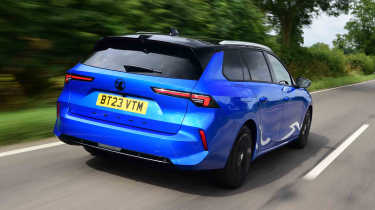
So far, we’ve tried the Astra Sports Tourer in both 1.6 Hybrid 180 and GSe plug-in hybrid versions, but there will also be a regular 128bhp 1.2-litre petrol or a 134bhp mild-hybrid e-DCT6 for those unable to plug their Astra into the mains, along with a 154bhp all-electric version for those who can plug in. All engines are also used in the closely related Peugeot 308 SW.
When it comes to its dynamics, the plug-in hybrid Sports Tourer feels pretty similar to other Astras. The steering is light, which helps to give the relatively long and large estate the sort of responsiveness you’d expect of something much smaller around town.
We’ve tested a GS trim version with 17-inch alloys. It comes as standard with these wheels, and we wouldn’t suggest choosing the optional 18-inch rims. The Sports Tourer’s ride is fine around town, and is no worse than the 308 SW upon which it’s based, because there’s still plenty of suspension travel to soak up the worst bumps. Head out onto faster B roads, and the high-ish kerbweight of 1,717kg gives the hybrid Sports Tourer a tendency to fidget on rough roads – and this will only be made worse with larger wheels.
The GSe receives fancier frequency-selective dampers to tighten its responses, and it sits 10mm lower on 11 per cent stiffer springs. As a result, it tends to follow the contours of the road more resolutely than the standard Astra Sports Tourer. The broader operating range of the new dampers means that the ride comfort hasn’t suffered – although it hasn’t gotten any better, either, because it can still feel jittery over rippled surfaces.
Vauxhall’s positioning within Stellantis means it offers a slightly sportier approach than Peugeot. We wouldn’t say the Astra is noticeably more dynamic than a Peugeot 308 SW, nor would we call the ‘sportier’ GSe something approaching a hot hatch. It weighs even more than the regular car (1,746kg) and feels heavy-handed and unwilling when tackling tight corners. Greedy throttle applications easily overwhelm the front wheels, forcing the driver to dial back the commitment. The Sports Tourer feels more settled at moderate speeds, and its shortcomings as a performance car are easier to accept, given its more practical brief over the hatchback.
The Astra Hybrid 180 powertrain’s throttle response is a little delayed, as are the eight-speed automatic’s shifts, even when you move from ‘Hybrid’ to ‘Sport’ mode. Crucially, though, the combination of the petrol engine and electric motor means the PHEV never feels underpowered – even if the engine does sound stressed in the upper reaches of the rev range if you push it.
It’s around town in ‘Electric’ mode where the PHEV feels most impressive. It nips between junctions confidently thanks to its punchy low-speed performance. The electric motor’s assistance helps cover any lethargy in the eight-speed automatic gearbox as it shuffles through its gears. The power sources don't always blend seamlessly, though, and it can be challenging to meter out the throttle when pulling away from a standstill. The brake pedal combines motor regeneration with the physical discs and pads, but as with the gearbox and electric motor combination, it results in an inconsistent pedal feel.
Based on our experience with the hatchback, the 1.2-litre petrol with a six-speed manual is the nicest to drive, and we’ll update this section once we’ve gotten behind the wheel of one.
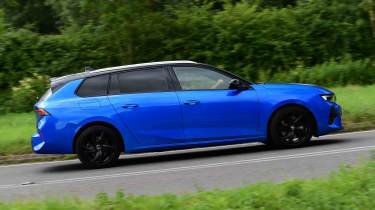
0-62mph acceleration and top speed
So far, we’ve driven the 1.6 180 and 1.6 225 GSe plug-in hybrid versions, the quickest of which is the GSe, with a 0-62mph time of 7.5 seconds thanks to its 1.6 petrol and electric motor combination putting out 222bhp and 360Nm of torque. Its top speed is 146mph – if you can find somewhere legal to do this.
However, the regular 1.6 180 PHEV Astra isn’t much slower. It produces less power at 178bhp but the same amount of torque at 360Nm, enough to accelerate from 0-62mph in 7.7 seconds and hit a top speed of 140mph.
The 1.2-litre turbocharged petrol has 128bhp, and manages the 0-62mph sprint in 10 seconds for the six-speed manual, or 9.9 seconds when equipped with an eight-speed automatic. Going for the slightly more powerful 134bhp e-DCT6 mild-hybrid cuts this time down to 9.3 seconds.
The Astra Sports Tourer Electric treads the middle ground between the petrol and plug-in hybrid models, and takes 9.2 seconds to do the same acceleration sprint.
MPG, CO2 and Running Costs
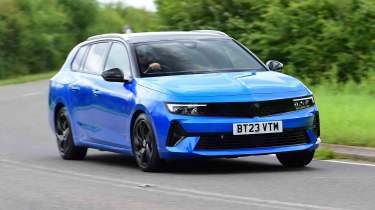
According to Vauxhall, the Astra petrol models with a manual gearbox manage 50.4mpg on the WLTP combined cycle, while the automatic version drops this to 49.6mpg. For those questioning the lack of a diesel, there is a mild-hybrid model that manages 58.9mpg.
That’s fine, but the hybrid Toyota Corolla Touring Sports offers over 60mpg in both 1.8 and 2.0-litre guises. True, the plug-in hybrid models have a WLTP figure of 235mpg for the Hybrid 180 and 217mpg for the GSe, but you’ll need to regularly charge up in order to get anywhere near that in real-world driving.
The petrol Astra Sport Tourer’s CO2 emissions range from 127g/km to 131g/km, so business users will be looking at Benefit-in-Kind (BIK) rates of 31 for the manual and 32 per cent for the auto – not the most competitive figures in a growing age of electrification where the Corolla Touring Sports is in the 26 and 27 per cent tax bands, depending upon which engine you go for.
Fortunately, the Astra Sports Tourer has a plug-in hybrid model which can travel up to 42 miles on electric power alone. With CO2 emissions of 23-25g/km, the PHEV models have a much more attractive 13 per cent BIK rating for company car drivers, while the all-electric version is even more affordable in the three per cent tax band.
Both versions of plug-in hybrid use the same size battery, so recharging their 12.4kWh (10.4kWh usable) battery using a 7kW home wallbox will take around two hours.
The all-electric version has a range of 256 miles, and has exactly the same charging time as the hatchback. If you can find a rapid charger capable of supplying 100kWh of charging speed, you should be able to charge from 20 to 80 per cent in less than half an hour. Refilling a flat battery at home using a 7kW wallbox will likely take around eight hours.
Insurance groups
Insurance premiums for the Astra Sports Tourer won’t be particularly cheap as some of its rivals, with the entry-level 128bhp Design model sitting in group 18 (out of 50). The least powerful 123bhp Ford Focus Estate in Titanium trim is a few insurance groups lower (15 out of 50), while the least expensive Kia Ceed Sportswagon is in group 13.
Moving through the Astra Sports Tourer line-up, the electric version starts in group 26, while the 178bhp plug-in hybrid is in group 27. The performance-oriented GSe sits in group 31.
Depreciation
According to our expert data, the eighth-generation Astra Sports Tourer should hold on to 44-48 per cent of its value after a typical three-year/36,000-mile ownership period, with the best version being the electric version in Griffin trim.
That’s on a par with the SEAT Leon Estate and Peugeot 308 SW, although the Corolla Touring Sports retains between 49 to 52 per cent of its value over the same period, with the 2.0-litre GR Sport model the top performer.
To get an accurate valuation on a specific model check out our free car valuation tool...
Interior, design and technology
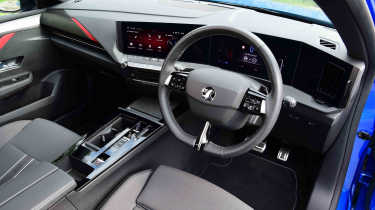
Vauxhall’s new design language emphasises terms like ‘Bold’ and ‘Pure’. While we’ll leave you to make your own mind up on the new ‘Vizor’ grille, there’s no denying it’s a strong departure from the previous-generation car’s design.
The cabin includes plusher materials than before, with soft-touch plastics, and even some Alcantara inserts on the door cards of Ultimate trim models. It’s let down by cheaper plastics on the centre console and lower door cards, which is disappointing, and while the gloss piano black trim looks good when new, it’s easily marked.
The trim structure is made of Design, Griffin, GS and Ultimate – plus the standalone GSe model as the high-performance choice. All trims come with a sportier-looking black exterior trim, but you can identify GS cars and above thanks to a black Vauxhall badge on the front grille replacing the chrome version on lower trim levels, along with tinted rear windows.
The mid-range GS trim is our pick because, as well as the larger rims, it also includes a 360-degree parking camera system, keyless entry and an upgraded infotainment system. Adaptive LED headlights, a punchier sound system, a head-up display, a panoramic sunroof and wireless smartphone charging are added to the Ultimate trim. The ‘sportiest’ GSe model has model-specific bumper and alloy wheel designs, and is the only way you can get the most powerful plug-in hybrid engine.
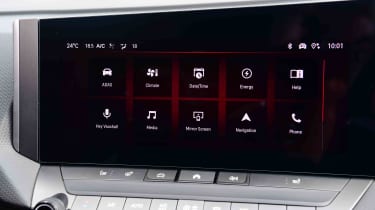
Sat-nav, stereo and infotainment
All Astras feature Vauxhall’s Pure Panel infotainment set-up as standard, but GS and Ultimate spec models receive an upgraded Pure Panel Pro system. Both consist of two 10-inch screens, one covering media functions and the other a digital instrument display providing information for the driver. Wireless Android Auto and Apple CarPlay are both included, along with a natural voice recognition system that we found to be both intuitive and accurate. However, loading times are a little slow, in our opinion. Plus, we found the auto-dimming of the screens, which occurs when going through short tunnels, can make the screen impossible to read for a few seconds.
The dual-screen set-up looks great when fully illuminated, and the Astra’s graphics look sharp. The reversing camera has great definition, too. We also like that Vauxhall has stuck with physical shortcut buttons and climate controls that are easier to use when on the move than touch-sensitive sliders, which have been a real bugbear of the Volkswagen Golf.
The head-up display is excellent because it shows key information and isn’t distracting while driving. We also found adjusting its position child’s play, using the electric door mirror controls to adjust it to your line of sight. Many rivals could learn from this (take note BMW), because you often need to dive into various sub-menus in order to find the screen adjustment menu.
Practicality, comfort and boot space
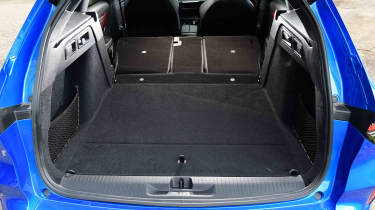
The cabin of the Astra Sports Tourer is lifted from the regular Astra hatchback, and on the whole, it’s a nice place to be. It has plenty of storage options and lots of useful standard kit.
There’s a big cubby located between the front seats, two trays with sliding covers and a fold-out section below the central air vent that can be used to store a phone or sunglasses. Griffin spec models and above feature a front centre armrest with cupholders, a heated steering wheel and heated front seats. Those seats have certification from the AGR (The Campaign for Healthier Backs in Germany) and include additional adjustments to improve comfort on long journeys.
In the back, the shallow windows let a surprising amount of light in, while headroom should be fine for most. However, if you’re sitting behind a tall person, you may find your knees are either poking their back or straddling the seat.
Front and rear parking sensors come as part of the entry Design specification, while our preferred GS model has a 360-degree parking camera to help out when parking.
Size
The Astra Sports Tourer measures 4,642mm in length, is 1,860mm wide (2,062mm including door mirrors), and 1,443mm in height. That makes it 268mm longer than the regular Astra hatchback, although only 57mm of this goes into a longer wheelbase for the estate version.
For context, a Skoda Octavia Estate is longer at 4,689mm, which goes some way into explaining why it offers more space inside.
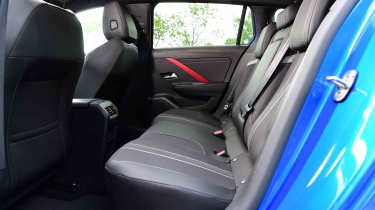
Leg room, head room and passenger space
While the room up front is good, passengers travelling in the rear seats will find things a little tighter; there’s a decent amount of headroom, but more legroom would be welcome. Those likely to put tall teens or adults in the back regularly should look at an Octavia Estate instead.
There's plenty of room for passenger's feet under the front seats, though, and the central hump in the floor is much lower in the Vauxhall than in a Golf.
Two ISOFIX points are provided on the outer rear seating positions.
Boot
Storage space in the Astra estate is, obviously, much more practical than the hatchback. As a plus point, the 40/20/40 split folding rear seats offer greater flexibility than rivals like the Ford Focus Estate and VW Golf Estate. However, its 597-litre capacity isn’t the greatest and comes up short of the 640-litres provided by the Octavia Estate. Dropping the rear seats yields 1,634 litres of space, which is still down on the Octavia Estate.
The plug-in hybrid and electric versions have a slightly compromised boot compared with petrol models, with boot space dropping from 597 litres to 516 litres. That’s actually more than you’ll find in plug-in hybrid versions of the SEAT Leon Estate, so it compares well with its closest rivals. Folding all the seats down reveals 1,533 litres of space.
Towing
The 1.2-litre petrol Astra Sports Tourer with a manual transmission can tow a braked trailer that weighs up to 1,200kg. The same 1.2 equipped with an automatic gearbox has the same towing capacity as the plug-in hybrid and GSe models: 1,400kg. The electric version isn't rated to tow, but you can with the 136bhp mild-hybrid, but only up to 1,100kg.
Those are all competitive numbers, but if you need even more capacity, you’ll be better off with either an Octavia Estate or Golf Estate in 2.0 TDI 150 DSG auto form, because both can lug around a 1,600kg trailer or caravan.
Reliability and Safety
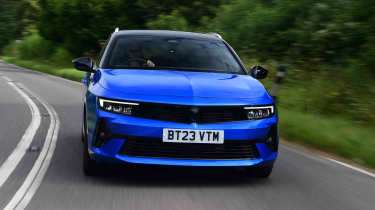
Vauxhall has equipped all Astra Sports Tourer models with lane departure warning and lane-keep assist, speed sign recognition, a driver drowsiness alert, adaptive cruise control, and autonomous emergency braking (AEB). Mid-range GS trim along with a more advanced collision alert system that works at higher speeds, while top-of-the-range Ultimate and GSe add blind spot monitoring and a lane position assist feature.
Unfortunately, the Astra Sports Tourer (just like its Astra hatchback sibling) received a four-star Euro NCAP score. That’s one lower than its Seat Leon Estate, Skoda Octavia Estate, and VW Golf Estate rivals. The safety experts criticised the lack of a central airbag to protect front seat occupants in a side-on collision, and the emergency braking system for its poor response in recognising pedestrians.
The latest Astra didn't feature in the 2024 Driver Power owner satisfaction survey, but the brand came in a disappointing 26th place out of 32 manufacturers, two places lower than the previous 2023 result. Owners praised the running costs, but had issues in every other area. That's a shame given that sibling brands Peugeot and Citroen both did better, coming sixth and fifth in the same survey, respectively.
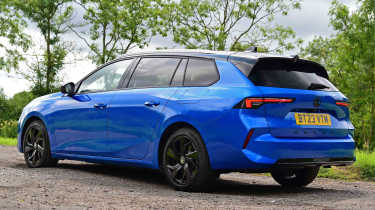
Warranty
All Vauxhall cars are covered by a three-year/60,000-mile warranty, which matches the coverage you get with a Ford Focus Estate or Volkswagen Golf Estate, but lags behind the seven-year warranty offered by Kia, or the ten-year warranty package provided by Toyota.
Plug-in hybrid and Astra Sport Tourer Electric models have a separate eight-year or 100,000-mile policy for the battery pack. If the battery’s usable capacity drops below 70% during that time, Vauxhall will replace it for free.
Servicing
If you own a petrol-powered Astra Sports Tourer, then it’ll need a service every 12,500 miles or annually, while plug-in hybrid models are every 12-months/20,000, whichever comes first.
The Astra Sports Tourer Electric will likely follow its hatchback sibling in needing an initial service after one year or 8,000 miles, whichever comes soonest, then it’ll need to be serviced every two years or 16,000 miles from that point onwards.
Vauxhall offers a range of servicing packages; Vauxhall Care is the most comprehensive, offering three years of servicing, two years of roadside assistance and a free MoT when your car needs it. Standalone fixed-price services are also available, plus a 12-month warranty on any work carried out.
Frequently Asked Questions
The latest Vauxhall Astra Sports Tourer provides a greater range of engines and alternative power sources than its rivals, comes well-equipped, and is refined and nice to drive. It is a shame about the four-star Euro NCAP safety rating, though.

